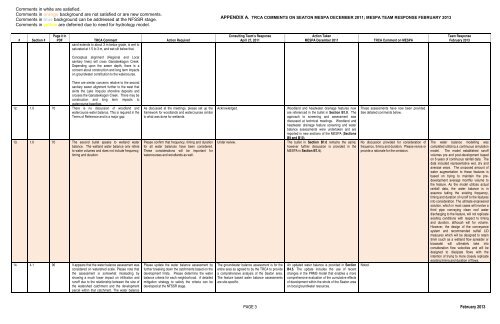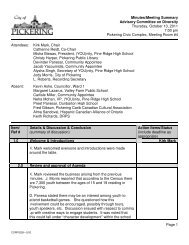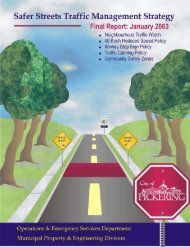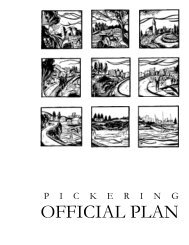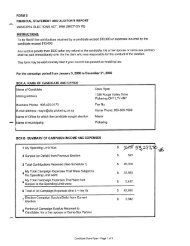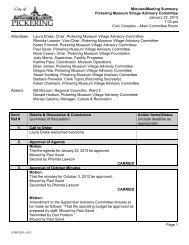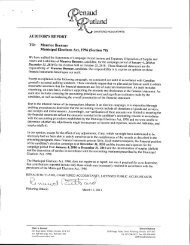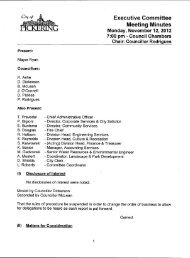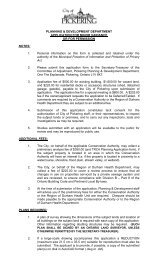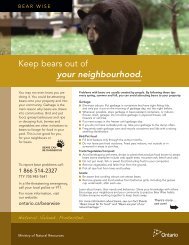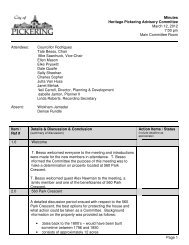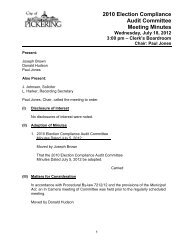Chapter A - Introduction - City of Pickering
Chapter A - Introduction - City of Pickering
Chapter A - Introduction - City of Pickering
Create successful ePaper yourself
Turn your PDF publications into a flip-book with our unique Google optimized e-Paper software.
Comments in white are satisfied.<br />
Comments in orange background are not satisfied or are new comments.<br />
Comments in blue background can be addressed at the NFSSR stage.<br />
Comments in yellow are deferred due to need for hydrology model.<br />
APPENDIX A. TRCA COMMENTS ON SEATON MESPA DECEMBER 2011; MESPA TEAM RESPONSE FEBRUARY 2013<br />
# Section #<br />
Page # in<br />
PDF TRCA Comment Action Required<br />
sand extends to about 3 m below grade, is wet to<br />
saturated at 1.5 to 3 m, and wet silt below that.<br />
Consulting Team’s Response<br />
April 27, 2011<br />
Action Taken<br />
MESPA December 2011<br />
TRCA Comment on MESPA<br />
Team Response<br />
February 2013<br />
Conceptual alignment (Regional and Local<br />
sanitary lines) will cross Ganatsekiagon Creek.<br />
Depending upon the sewer depth, there is a<br />
concern about construction and long term impacts<br />
on groundwater contribution to the watercourse.<br />
There are similar concerns relative to the second<br />
sanitary sewer alignment further to the west that<br />
skirts the Lake Iroquois shoreline deposits and<br />
crosses the Ganatsekiagon Creek. There may be<br />
construction and long term impacts to<br />
watercourse baseflow.<br />
12. 1.0 70 There is no discussion <strong>of</strong> woodland and<br />
watercourse water balance, This is required in the<br />
Terms <strong>of</strong> Reference and is a major gap.<br />
13. 1.0 70 The second bullet speaks to wetland water<br />
balance. The wetland water balance only refers<br />
to water volumes and does not include frequency,<br />
timing and duration.<br />
14. 4.1 96 It appears that the water balance assessment was<br />
considered on watershed scale. Please note that<br />
the assessment is somewhat misleading by<br />
showing a much lower impact on infiltration and<br />
run<strong>of</strong>f due to the relationship between the size <strong>of</strong><br />
the watershed catchment and the development<br />
parcel within that catchment. The water balance<br />
As discussed at the meetings, please set up the<br />
framework for woodlands and watercourses similar<br />
to what was done for wetlands.<br />
Please confirm that frequency, timing and duration<br />
for all water balances have been considered.<br />
These considerations will be important for<br />
watercourses and woodlands as well.<br />
Please update the water balance assessment by<br />
further breaking down the catchments based on the<br />
development limits. Please determine the water<br />
balance criteria for each neighborhood. A detailed<br />
mitigation strategy to satisfy the criteria can be<br />
developed at the NFSSR stage.<br />
Acknowledged.<br />
Under review.<br />
The groundwater balance assessment is for the<br />
entire area as agreed to by the TRCA to provide<br />
a comprehensive analysis <strong>of</strong> the Seaton area.<br />
The feature based water balance assessments<br />
are site-specific.<br />
Woodland and headwater drainage features now<br />
are referenced in the bullet in Section B1.0. The<br />
approach to screening and assessment was<br />
discussed at technical meetings. Woodland and<br />
headwater drainage feature screening and water<br />
balance assessments were undertaken and are<br />
reported in new sections <strong>of</strong> the MESPA (Sections<br />
B9 and B10).<br />
The bullet in Section B1.0 remains the same;<br />
however further discussion is provided in the<br />
MESPA in Section B7.4).<br />
An updated water balance is provided in Section<br />
B4.5. The update includes the use <strong>of</strong> recent<br />
changes in the PRMS model that enables a more<br />
comprehensive evaluation <strong>of</strong> the cumulative effects<br />
<strong>of</strong> development within the whole <strong>of</strong> the Seaton area<br />
on local groundwater resources.<br />
These assessments have now been provided.<br />
See detailed comments below.<br />
No discussion provided for consideration <strong>of</strong><br />
frequency, timing and duration. Please revise or<br />
provide a rationale for the omission.<br />
Noted.<br />
The water balance modelling was<br />
completed utilizing a continuous simulation<br />
model. The model established run<strong>of</strong>f<br />
volumes pre and post-development based<br />
on 6 years <strong>of</strong> continuous rainfall data. The<br />
data included representative wet, dry and<br />
average years. The proposed amount <strong>of</strong><br />
water augmentation to these features is<br />
based on trying to maintain the predevelopment<br />
average monthly volume to<br />
the feature. As the model utilizes actual<br />
rainfall data, the water balance is in<br />
essence taking the existing frequency,<br />
timing and duration <strong>of</strong> run<strong>of</strong>f to the features<br />
into consideration. The ultimate engineered<br />
solution, which in most cases will involve a<br />
third pipe conveying clean ro<strong>of</strong> water<br />
discharging to the feature, will not replicate<br />
existing conditions with respect to timing<br />
and duration, although will for volume.<br />
However, the design <strong>of</strong> the conveyance<br />
system and recommended outfall LID<br />
measures which will be designed to retain<br />
5mm (such as a wetland flow spreader or<br />
bioswale) will ultimately take into<br />
consideration flow velocities and will be<br />
designed to dissipate flows with the<br />
intention <strong>of</strong> trying to more closely replicate<br />
existing timing and duration <strong>of</strong> flows.<br />
PAGE 3 February 2013


